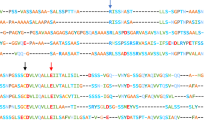Abstract
Spider silk is one of nature’s most remarkable biomaterials due to extraordinary strength and toughness not found in today’s synthetic materials. Of the seven types of silk, wrapping silk (AcSp1) is the most extensible of the types of silks and has no sequence similarity to the other types. Here we report the chemical shifts for the AcSp1 199 amino acid protein repeat unit and its anticipated secondary structure based on secondary chemical shifts.



Similar content being viewed by others
References
Cheung MS, Maguire ML, Stevens TJ, Broadhurst RW (2010) DANGLE: a Bayesian inferential method for predicting protein backbone dihedral angles and secondary structure. J Magn Reson 202(2):223–233. doi:10.1016/j.jmr.2009.11.008
Delaglio F, Grzesiek S, Vuister GW, Zhu G, Pfeifer J, Bax A (1995) NMRPipe: a multidimensional spectral processing system based on UNIX pipes. J Biomol NMR 6(3):277–293
Hardy JG, Römer LM, Scheibel TR (2008) Polymeric materials based on silk proteins. Polymer 49(20):4309–4327. doi:10.1016/j.polymer.2008.08.006
Lewis RV (2006) Spider silk: ancient ideas for new biomaterials. Chem Rev 106(9):3762–3774. doi:10.1021/cr010194g
Lin Z, Huang W, Zhang J, Fan JS, Yang D (2009) Solution structure of eggcase silk protein and its implications for silk fiber formation. Proc Natl Acad Sci USA 106(22):8906–8911. doi:10.1073/pnas.0813255106
Ulrich EL, Akutsu H, Doreleijers JF, Harano Y, Ioannidis YE, Lin J, Livny M, Mading S, Maziuk D, Miller Z, Nakatani E, Schulte CF, Tolmie DE, Kent Wenger R, Yao H, Markley JL (2008) BioMagResBank. Nucleic Acids Res 361(Database issue):D402–D408. doi:10.1093/nar/gkm957
Vranken WF, Boucher W, Stevens TJ, Fogh RH, Pajon A, Llinas M, Ulrich EL, Markley JL, Ionides J, Laue ED (2005) The CCPN data model for NMR spectroscopy: development of a software pipeline. Proteins 59(4):687–696. doi:10.1002/prot.20449
Wishart DS, Sykes BD, Richards FM (1992) The chemical shift index: a fast and simple method for the assignment of protein secondary structure through NMR spectroscopy. Biochemistry 31(6):1647–1651
Wishart DS, Bigam CG, Holm A, Hodges RS, Sykes BD (1995a) 1H, 13C and 15N random coil NMR chemical shifts of the common amino acids I Investigations of nearest-neighbor effects. J Biomol NMR 5(1):67–81
Wishart DS, Bigam CG, Yao J, Abildgaard F, Dyson HJ, Oldfield E, Markley JL, Sykes BD (1995b) 1H, 13C and 15N chemical shift referencing in biomolecular NMR. J Biomol NMR 6(2):135–140
Acknowledgments
We thank Yanfei Wang for technical support in the gene preparation. This work was supported by a research grant from the Canadian Institutes of Health research to XQL; a Discovery Grant from the Natural Sciences and Engineering Research Council of Canada to JKR; research grants to QM from the National High Technology Research and Development Program 863 (NO 2006AA03Z451), the National Natural Science Foundation of China (NO 31070698), and the Shanghai key projects of basic research (NO 10JC1400300); and, a Nova Scotia Health Research Foundation Studentship Award to MLT. 700 MHz NMR data were collected at the Biomolecular Magnetic Resonance Facility (BMRF) housed at the National Research Council of Canada’s Institute for Marine Biosciences (NRC-IMB), as facilitated by the Nuclear Magnetic Resonance Research Resource (NMR-3). The He-cooled probe for the 700 MHz at the NRC-IMB was provided by Dalhousie University through an Atlantic Canada Opportunities Agency Grant. 500 MHz NMR experiments were recorded at the Québec/Eastern Canada High Field NMR Facility (QANUC), supported by grants from the Canada Foundation for Innovation, the Natural Sciences and Engineering Research Council of Canada, the Québec ministère de la recherche en science et technologie, and McGill University. Thanks to Dr. Tara Sprules for her expert data acquisition at QANUC.
Author information
Authors and Affiliations
Corresponding authors
Additional information
Lingling Xu and Marie-Laurence Tremblay contributed equally.
Rights and permissions
About this article
Cite this article
Xu, L., Tremblay, ML., Meng, Q. et al. 1H, 13C and 15N NMR assignments of the aciniform spidroin (AcSp1) repetitive domain of Argiope trifasciata wrapping silk. Biomol NMR Assign 6, 147–151 (2012). https://doi.org/10.1007/s12104-011-9344-z
Received:
Accepted:
Published:
Issue Date:
DOI: https://doi.org/10.1007/s12104-011-9344-z




